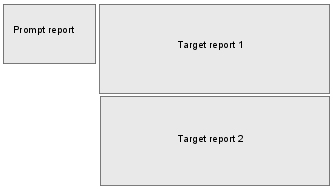The prompts and the target reports in a page
or a dashboard create an interactive and easy way to access IBM® Cognos® Business
Intelligence environment.
Each report is displayed using the IBM Cognos Viewer
portlet. The reports communicate with each other using the properties
of this portlet.
You can use different design strategies to
implement global filters in a page. The following figure shows an
example of a basic page layout:
Use the following steps when defining global filters in
a single page. If you want to implement this functionality in a dashboard,
you must complete additional steps. For more information, see Create a Dashboard with Multiple Tabs.
Procedure
- In IBM Cognos Connection, click the new page button
 .
.
- Type the name, and select a location for your page.
- Click Next.
- In the Set columns and layout page,
set the number and width of columns.
For example, the
reports that display the prompts and prompt controls can be placed
in one column, and the target reports in a separate column to the
right.
- Click Add at the bottom of the first
column.
- In the Available Entries box, click IBM
Cognos Content.
- Select the IBM Cognos Viewer portlet,
click the right arrow button
 to move the portlet to the Selected
Entries box, and click OK.
to move the portlet to the Selected
Entries box, and click OK.
- Repeat steps 5 to 7 for each column.
You
must add the IBM Cognos Viewer portlet for each report that
you want to include in the column. For example, if the column on the
left will contain a prompt and prompt controls, add two IBM Cognos Viewer
portlets.
- Click Next.
- Complete the remaining steps in the wizard, if needed,
and click Finish.
For more
information, see the steps in the section Create a Page.
- Go to the folder where you saved the new page, and open
it.
In the page columns, you can see the empty frames
of the IBM Cognos Viewer portlets.
- For any portlet in the page, click the edit button
 in the
portlet toolbar.
in the
portlet toolbar.
- In the portlet properties page, click Select
an entry to select the report you want to display in the
portlet.
- Click Report Properties.
The Set
the properties page appears.
- For the Fragment Action property,
specify the default portlet action when the portlet is invoked in
a page.
You can choose to show the run icon, run the
report, or view the most recent saved output.
Tip: For
more information about the portlet properties, click the Help button
in the portlet.
- For the Prompt the user property,
specify how to execute the prompts.
- When you select Every time, if the report
contains optional or required prompts, the user is prompted to enter
the prompt values before the report is run.
- When you select Only when required parameter values
are missing, the user is prompted if the report contains
required prompts and the values are missing. Otherwise the report
runs successfully.
- When you select Never and show the report only when
required values are provided, IBM Cognos Viewer
attempts to run the report, but the page remains hidden until the
required prompt values are provided.
- When you select Based on the prompt settings of the
report, IBM Cognos Viewer uses the prompts
specified in the report.
- For the Prompt values property,
select the Communicate with other portlets check
box.
This property enables communication between this
portlet and other portlets in the page that have this property set
up.
- If you want to set up communication between only specific
portlets in the page, type the channel name in the box provided.
Only the portlets that share the same channel name can interact.
By specifying the channel name, you have more control over the page.
For example, you can link only the reports that have matching parameters.
For
more information about this property, click the Help button
in the portlet.
- If you selected the Communicate with other portlets check
box, you can specify how global prompts are matched. Select either Parameter
name or data item or Parameter name only.
Typically, prompt values are matched using the parameter
name only. However, for date and time prompts, such as From and To,
using the parameter name may not work because the parameter names
are using the same data item, for example, Order date. In these situations,
use the Parameter name or data item option
to get the correct results in your reports.
- If you want to see the portlet toolbar in the page, for
the Show Toolbar property, select the Normal
mode and Maximize mode check boxes.
- Click OK to close the Set
the properties page, and click OK again
to close the general properties page.
- Repeat steps 12 to 20 for each portlet in the page.


 .
.  to move the portlet to the
to move the portlet to the  in the
portlet toolbar.
in the
portlet toolbar.